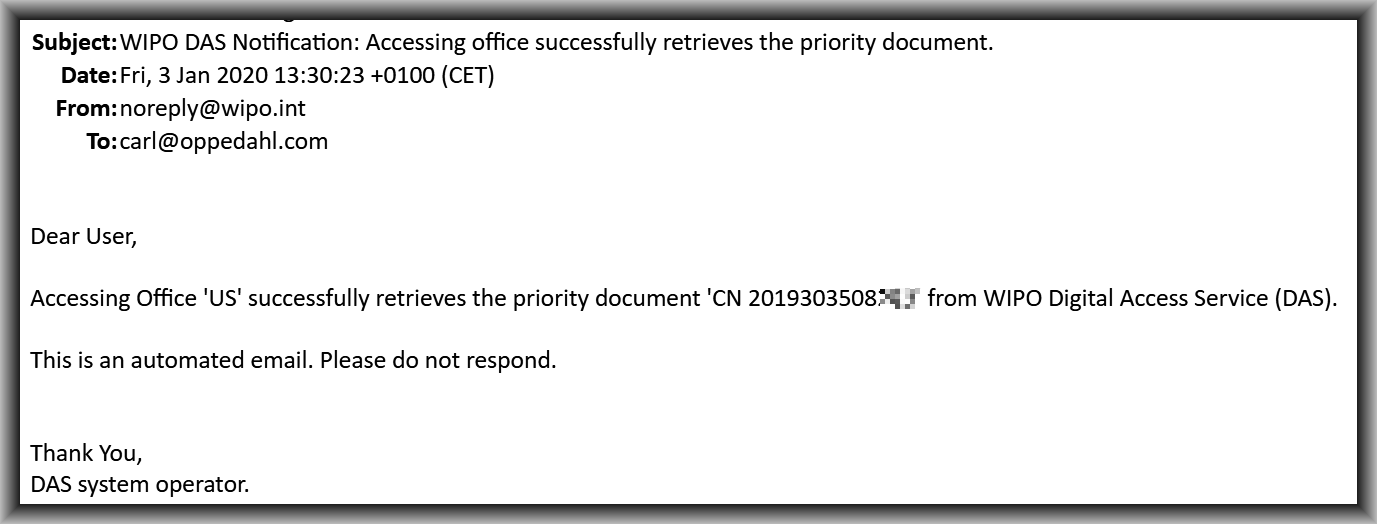
(Update: A letter got sent on February 22, 2020 to the Commissioner for Patents at the USPTO, asking the USPTO to pull the plug on DAS. See blog post.)
Yesterday in one of our cases, the USPTO retrieved an electronic certified copy of an EP priority application. In and of itself, this was routine news, except that we had to learn about this happy event by accident. Just accidentally I had this case open in Private PAIR and happened to click in IFW to see that the electronic certified copy had arrived.
The key thing here is that if our US case had claimed priority from almost any other Office than EPO, we would have been told in an automatic way, by email, that the successful retrieval had taken place. But no such automatic email arrived for this EP priority application. Why is this bad situation the way it is?
The short answer is that USPTO has not somehow managed to pull the plug on PDX. USPTO ought to do this now, so that USPTO’s US customers could get the benefit of such automatic email notifications. USPTO ought to have done this fourteen months ago, but has not done it despite having been reminded many times including this November 1, 2018 blog article and this February 9, 2019 blog article.
If you were to file a US utility or design application that claims priority from an application filed in any of a long list of other Offices, you would be able to receive an automatic notification from DAS when USPTO retrieves the electronic certified copy. Here are the fifty-six kinds of priority applications for which you could file a US application, claim priority, and get the benefit of the DAS monitoring functions:
- Argentina (for national patent applications)
- Australia (for national patent applications, for RO/AU applications, and for design applications)
- Brazil (for national patent applications and for RO/BR applications)
- Canada (for design applications)
- Chile (for national patent applications, for RO/CL applications, for utility model applications, and for design applications)
- China (for national patent applications, for RO/CN applications, for utility model applications, and for design applications)
- Denmark (for national patent applications and for RO/DK applications)
- Estonia (for national patent applications and for utility model applications)
- Eurasian Patent Organization (for national patent applications and for RO/EA applications)
- Finland (for national patent applications, for RO/FI applications and for utility model applications)
- Georgia (for national patent applications, for RO/GE applications, for utility model applications, and for design applications)
- India (for national patent applications, for RO/IN applications, and for design applications)
- Israel (for national patent applications and for RO/IL applications)
- Japan (for national patent applications, for utility model applications, and for design applications)
- Morocco (for national patent applications and for RO/MA applications)
- Netherlands (for national patent applications and for RO/NL applications)
- New Zealand (for national patent applications)
- Norway (for national patent applications, for RO/NO applications, and for design applications)
- South Korea (for national patent applications, for utility model applications, and for design applications)
- Spain (for national patent applications, for RO/ES applications, for utility model applications, and for design applications)
- Sweden (for national patent applications and for RO/SE applications)
- United Kingdom (for national patent applications)
- WIPO (for RO/IB applications and for Hague applications)
Yes there are fifty-seven kinds of priority applications which the USPTO could obtain from DAS, and for which the US applicant is able to monitor the retrieval. But only the fifty-six kinds of application listed above are actually available to US applicants in this way. The fifty-seventh is not. If you have the bad luck that your US application claims priority from an EP application instead of from one of these other fifty-six kinds of application, you are not able to use DAS to monitor the situation.
USPTO needs to pull the plug on PDX now. No more foot-dragging, please.
Do you use DAS to monitor USPTO’s retrieval of electronic certified copies? Please post a comment below.
If you don’t know how to use DAS to monitor USPTO’s retrieval of electronic certified copies, take the DAS quiz and you can learn how to do it.

3 Replies to “USPTO dragging its feet on unplugging PDX”